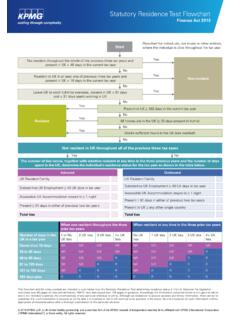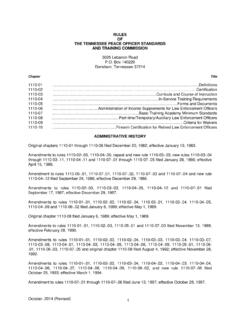Transcription of Statutory guidance on the roles and responsibilities of ...
1 Statutory g uidance on the roles and responsibilities of the Director of Children s Services and the Lead Member for Children s Services For local authorities April 2013 2 Contents Summary 3 About this guidance 3 Review date 3 What legislation does this guidance refer to? 3 Who is this guidance for? 3 Key points 3 The Director of Children s Services and Lead Member for Children s Services 5 The Director of Children s Services (DCS) 5 The Lead Member for Children s Services (LMCS 5 Ensuring a clear line of accountability 6 Additional functions not related to local authority children s services 6 Joint DCS appointments 7 Local assurance 7 roles and responsibilities of the DCS and LMCS 9 Leadership and partnership 9 Safeguarding 11 Vetting and barring scheme 11 Vulnerable children and yo ung people 12 Fair access to services 13 Educational excellence 14 Further sources of information 15 Associated resources (external links) 15 Other departmental advice and guidance you may be interested in 15 3 Summary About this guidance This is Statutory guidance issued by the Secretary of State for Education.)
2 Local authorities in England1 must have regard to it in relation to the appointment of the Director of Children s Services (DCS) and the designation of the Lead Member for Children s Services (LMCS). This guidance covers the legislative basis for the two appointments, roles and responsibilities of the post holders, and how this relates to Government expectations about local authorities role in education and children and young people s services. Review date This guidance replaces the previous versions issued in 2005, 2009 and guidance will next be reviewed on an annual basis to check whether it is still fit for purpose: but it will only be revised if it is no longer considered fit for purpose. Annex A lists other sources of information and guidance and will be updated regularly. What legislation does this guidance refer to?
3 Sections 18(7) (Director of Children s Services) and 19(2) (Lead Member for Children s Services) of the Children Act 2004. This means that local authorities must have regard to it and, if they decide to depart from it, they will need to have clear reasons for doing so. Who is this guidance for? This guidance is for: Local authorities in England with responsibility for education and children s social services functions. Key points The Children Act 2004 requires every upper tier local authority to appoint a Director of Children s Services and designate a Lead Member for Children s Services. 1 References in this guidance to local authority education functions do not include further and higher education functions listed at section 18(3) of the Children Act 2004 4 The DCS and LMCS are appointed for the purposes of discharging the education and children s social services functions of the local authority.
4 The functions for which they are responsible are set out in section 18(2) of the Children Act 2004. This includes (but is not limited to) responsibility for children and young people receiving education or children s social care services in their area and all children looked after by the local authority or in custody (regardless of where they are placed). Within this legal framework, it is for individual local authorities to determine their own organisational structures in the light of their local circumstances. However, local authorities must ensure that there is both a single officer and a single elected member each responsible for both education and children s social care. The DCS and LMCS should each have an integrated children s services brief, ensuring that the safety and the educational, social and emotional needs of children and young people are central to the local vision.
5 Between them, the DCS and LMCS provide a clear and unambiguous line of local accountability. The DCS has professional responsibility for children s services, including operational matters; the LMCS has political responsibility for children s services. Together with the Chief Executive and Leader or Mayor2 the DCS and LMCS have a key leadership role both within the local authority and working with other local agencies to improve outcomes for children and young people. The DCS is a politically restricted Statutory chief officer post; they should be a first tier officer and report directly to the Chief Executive. Local authorities should, as a matter of course, assure themselves that their arrangements enable them to discharge their education and children s social care functions effectively. Given the breadth and importance of children s services functions that the DCS and LMCS cover, local authorities should give due consideration to protecting the discrete roles and responsibilities of the DCS and LMCS before allocating to them any additional functions other than children s services.
6 2 Local authorities that are considering adopting the committee system should take into account and implications for the DCS and LMCS roles 5 The Director of Children s Services and Lead Member for Children s Services The Director of Children s Services (DCS) 1) Secti on 18 of the Children Act 2004 requires every top tier local authority to appoint a Director of Children s Services. The DCS has professional resp onsibility for the leadership, strategy and effecti veness of loca l authority ch ildren s service s and, as such , this post sh ould be at first tier officer level. The DCS is responsible for securing the provision of se rvices which address the needs of all children and young people, including the most disadvantaged and vulnerable, and their families and ca rers.
7 In discharging these resp onsibilities, the DCS will work close ly with other local partners to improve the outcomes and well-being of ch ildren and young people. The DCS is responsible for the performance of local authority functions relating to the education and so cial care of children and young people. The DCS is responsible for ensu ring that effecti ve sy stems are in place for discharging these functi ons, including where a loca l authority has commissioned any se rvices from another provider rather than delivering them itself. The DCS should have regard to the General Principl es of the United Nations Convention on the Rights of the Child (UNCRC) and ensu re that children and young people are involved in the development and delivery of local se rvice s. 2) The DCS is a politically restricted Statutory chief officer post.
8 3 This means the post holder is prevented from taki ng part in certain political acti vities. In particular, the DCS is disqualified from being an elected member of the loca l authority. The DCS should report directly to the Chief Execu tive (Head of Paid Service), who in turn is accountable to the Council for the performance of its chief officers4 Local authoriti es are strongly encouraged to involve ch ild ren and young people in the appointment of the DCS. The Lead Member for Children s Services (LMCS) 3) Section 19 of the Children Act 2004 requires every top tier local authority to designate one of its members as Lead Member for Children s Services. The LMCS will be a local Councillor with delegated responsibility from the Council, through the Leader or Mayor5, for children s services. The LMCS, as a member of the Council Executive, has political responsibility for the leadership, strategy and effectiveness of local authority children s services.
9 The LMCS is also democratically accountable to local 3 Under section 2 of the Local Government and Housing Act (as amended) 4 See Schedule 1 to the Local Authorities (Standing Orders) (England) Regulations 2001 SI 3384 5 In Local authorities with governance models 6 communities and has a key role in defining the local vision and setting political priorities for children s services within the broader political context of the Council. 4) The LMCS is responsible for ensuring that the needs of all children and young people, including the most disadvantaged and vulnerable, and their families and carers, are addressed. In doing so, the LMCS will work closely with other local partners to improve the outcomes and well-being of children and young people. The LMCS should have regard to the UNCRC and ensure that children and young people are involved in the development and delivery of local services.
10 As politicians, LMCSs should not get drawn into the detailed day-to-day operational management of education and children s services. They should, however, provide strong, strategic leadership and support and challenge to the DCS and relevant members of their senior team as appropriate. Ensuring a clear line of accountability 5) Integrating education and children s social care services under a single officer and a single member provides both a strategic and professional framework within which the safety and the educational, social and emotional needs of children and young people are considered together. The DCS and LMCS roles provide a clear and unambiguous line of political and professional accountability for children s well-being. The DCS and LMCS should report to the Chief Executive and to the Council Leader or Mayor respectively as the post holders with ultimate responsibility for the political and corporate leadership of the Council and accountability for ensuring that the effectiveness of steps taken and capacity to improve outcomes for all children and young people is reflected across the full range of the Council s business.













